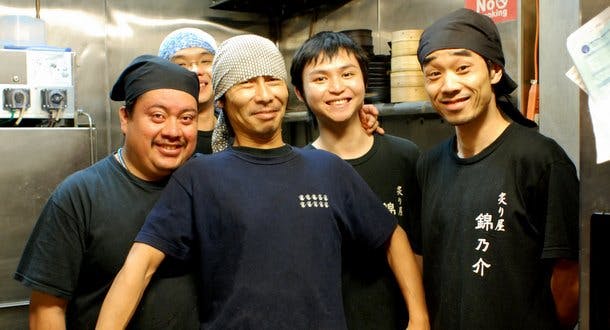
Tosajoyu, Katsuo Bushi-Infused Soy Sauce
Learn about robata grilling and how Chef Jiro Iida of Aburiya Kinnosuke restaurant in Manhattan creates tosajoyu, a soy sauce infused with the delicate, smoky flavor of katsuo bushi. Discover the recipe and technique for making tosajoyu and yakitori tare, Jiro-san's version of Japanese barbecue sauce. Find out where to get binchotan charcoal for robata grilling. Happy grilling!
Earlier this month Gourmet.com ran my story on robata grilling, which I put together thanks to Chef Jiro Iida (the man in the white checked bandana) of the terrific midtown Manhattan restaurant Aburiya Kinnosuke. Over the course of a few weeks, Jiro-san graciously invited me to his kitchen before service to watch him in action and teach me about robata. He explained a number of recipes and techniques, including the following one for tosajoyu, a condiment where soy sauce is infused with the delicate, smoky flavor of katsuo bushi.
Jiro-san's grandfather, also a chef, taught him this recipe when he first started cooking. Tosajoyu is a wonderful accent for grilled vegetables like eggplant, shiitake mushrooms and asparagus. The restaurant also serves tosajoyu as the dipping sauce for their sashimi.
Jiro-san uses a barbecue similar to a konro to grill vegetables, which allows him to lay the ingredients flat on a metal grate over fiery binchotan charcoal, rather than standing them upright like he does with meat or fish (my story explains this). He lightly brushes tosajoyu on the grilled vegetables only after they're finished, just before serving, so not to overpower their natural caramelized flavors.
Here's what you need:
1 1/2 cups koikuchi soy sauce (Japanese dark soy sauce)
1/2 cup sake
1/4 cup mirin
1/4 cup tamari (type of soy sauce brewed without wheat)
1 6-inch piece of konbu
1 oz katsuo bushi
- Combine all the ingredients in a stock pot. Place pot over low heat, gradually mixing katsuo bushi into the liquid. As soon as it reaches a boil, turn off the heat.
- When the pot returns to room temperature, place the unstrained liquid in the refrigerator
- Once the liquid cools (about an hour), remove the konbu and discard
- Keep the liquid mixture in the refrigerator for one week
- After a week, strain the liquid. Squeeze the katsuo bushi to release as much liquid as possible (it acts like a sponge). The remaining katsuo bushi can be dried at room temperature and enjoyed as a delicious condiment for steamed rice called furikake.
- Tosajoyu can keep in the refrigerator for up to a year
By the way, a couple of more points about robata:
The Gourmet.com story includes a recipe for yakitori tare, Jiro-san's version of a Japanese-style barbecue sauce to accent grilled chicken, one with complex, caramelized flavors produced by slow cooking. He recommends simmering his sauce for three to five hours-the longer the simmer, the deeper the flavor. This sauce is thinner than typical American barbecue sauces. Lightly brush it on grilled chicken after cooking as the last step, so not to overpower, the same idea as tosajoyu. Again, too, yakitori tare can stay in the fridge for up to a year.
Regarding the robata grilling itself, you can find binchotan charcoal at Korin Trading (online, too).
Happy grilling!
